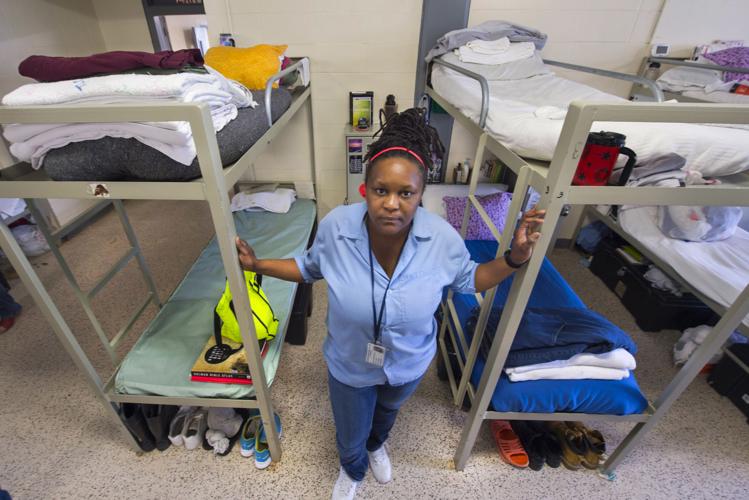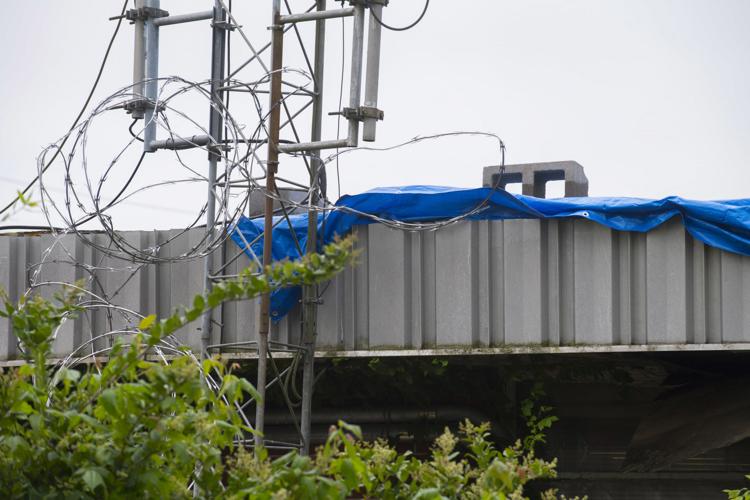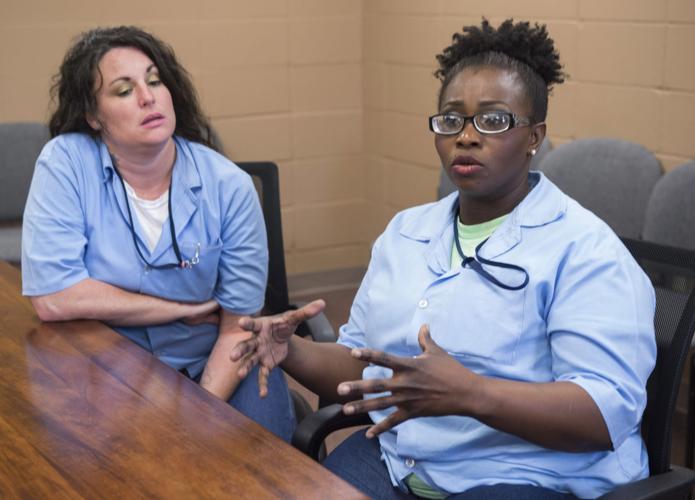At first, the roughly 1,000 women held at Louisiana's prison for women in St. Gabriel when it flooded in 2016 were told they'd be temporarily displaced.
About 250 were moved into the nearby men's prison and about 250 more to what was once a juvenile detention center in Baker, with the remainder shipped off to local jails or transitional programs scattered across the state.
Then, they were told they’d have to spend another year of living in overcrowded facilities, separated from the people who had become their adopted families behind bars. In addition to that deeply-felt loss, many no longer hold the jobs that used to give them a sense of purpose and pride.
But now it's stretched on for almost three years — and there seems to be no end in sight.
Angela Stokes lost nearly everything she gathered in her 26 years in prison when it flooded in August 2016, including photos of her now grown …
“When will we get back to normal?” said Tiffany Byrd, a prisoner housed in a crowded dorm at Elayn Hunt Correctional Center — a men’s prison — since the state’s facility for women flooded. “Temporary has become permanent. … It’s like they’ve forgotten about us.”
Without a fully-operating women's prison and still no realized plan to renew the old structure or completely rebuild it, the stress level and challenges have continued to build for both the inmate population and staff.

State corrections officials blame the continued delays on FEMA, which has yet to approve Louisiana's plan to knock down the flooded prison and rebuild. Without that approval, the bulk of the project's much-needed funds remain held up by the federal flood assistance program.
A FEMA spokeswoman said the agency is still trying to verify the extent of the flood damage to the prison, a slow process because of detailed legal and regulatory requirements that must be followed. In addition, she said, state corrections officials have changed their plans for fixing the women's prison which requires FEMA to vet updates.
So, for the time being, the women once held at LCIW are scattered across the state. The only signs of life at the abandoned women's prison these days are daily patrols conducted by three correctional officers and the few former inmates, including Byrd, who are brought in to maintain the grounds.
“It’s really heartbreaking seeing where I used to live, where I used to work, and having to see it in the devastating state that it’s in,” Byrd said. “And they’re not even doing anything.”
Her Elayn Hunt dorm-mate, Ashleigh Thornton, nodded along, equally disappointed by the lack of progress at the LCIW prison she used to call home: “Hey, we’re still here,” she said.
Prisoners waded out of the Louisiana Correctional Institute for Women six months ago, each clutching two laundry bags of belongings, as floodw…
Cramped quarters
Elizabeth Latson served the first 10 years of her 25-year sentence at LCIW, where she shared a room with one other woman.
“You were able to move around,” Latson said. “Especially if you were going through something, you were able to go back, seclude yourself.”
Since the flood, she’s been housed in a dorm at the previously-shuttered Jetson Center for Youth in Baker. She now sleeps in a bunk bed about two feet from the next double bunk, the room packed with almost 40 of the double bunks for the 71 women there.
“This is everyday life since the flood,” Latson said, extending her arm to easily touch the bed next to hers. “It’s a struggle.”
LCIW Warden Frederick Boutté said it’s even more cramped at the dorm at Elayn Hunt Correctional Center in St. Gabriel.
“These women are literally ... living on top of one another,” Boutté said. “In comparison to other state facilities, these women are jammed up. ...Everything they go through, somebody is staring at them, watching them go through it. I don’t think that’s optimal conditions.”
But to the women, even more important than the living conditions is who is there with them, or who is not.
“Just being separated is almost like being separated from your family,” said Sherri Sepulvado, a woman now incarcerated at the Baker facility. “You grow accustomed to spending every day of your life with this certain group of people and just the separation in itself is very, very difficult. ... You look to those people for support and you look to those people for guidance."
She trailed off, tears in her eyes.
“We are trying to pay our debt to society, but also get better in the meantime,” Thornton said. “A part of rehabilitation is love. ...And to be separated from (those people), it kind of sets you back a little bit.”
Almost 1,800 women are currently incarcerated by the state in Louisiana, and now more than 70 percent of them are at local facilities, not state-run prisons. Before the flood, nearly 1,000 were held at LCIW.
About a thousand inmates from the state's only women's prison are now being housed at various lockups, including privately-run facilities, aft…
The female prisoners who were interviewed by The Advocate, as well as the LCIW staff, said they are trying their best to make do and support each other but it’s still a daily challenge.
Boutté finds himself making the 40-mile drive between the Baker facility and Elayn Hunt multiple times each day to be available for the women. Despite being physically divided, he said, his employees remain staffed at the same levels as when they were at all together. And that has impacted some services, classes and daily operations.
Boutté said neither the re-purposed facility at Elayn Hunt nor the one at Jetson has a cafeteria for the women, which means food is brought into the dorms to eat, often cold by the time it arrives.
He also said cell space is lacking for inmates who occasionally need to be segregated from the general population for disciplinary reasons, so they have to be moved elsewhere. And while there are still classes, vocational programming and other services offered, they are now available to a smaller group of women, many only offered at the Baker location.
“Your whole way of life has been disrupted," Sepulvado said. "And it’s like we’re still scratching in the dirt to try to get things back together and scrambling just to have some bit of normalcy."
Can't see video below? Click here.
FEMA delays
Department of Corrections undersecretary Thomas Bickham said officials thought at first they could restore the buildings of LCIW in 2016 and spent about $8 million initially on cleaning. But now, as the buildings have sat in the Louisiana heat and moisture, the mold that was cleaned has returned and the facility has deteriorated further.
“We realized.. that this facility is not going to be usable as it stands today.” Bickham said. “It’s cost prohibitive to go up there and jackhammer walls, it’s more feasible to knock the whole building down.”
Prison officials have pivoted to a plan with an estimated $100 million price tag, hoping to demolish the current LCIW buildings — all but two that did not flood, which includes the chapel — and rebuild a state-of-the-art women’s prison, in line with today’s corrections standards.
Bickham said the cost also includes building the prison to the 500-year floodplain, which will allow the state to use it as an evacuation site for women prisoners during emergencies like hurricanes or another flood.
In 2016, women at the Livingston Parish jail were initially evacuated to LCIW, but had to be moved a second time when waters started also rising at the state facility, Bickham said. LCIW was built to 100-year flood levels.
Bickham said they still do not know how much of the $100 million price tag that FEMA will cover.
But he said he expects the state to eventually get federal reimbursement for the cost of housing at local jails the 400 women for whom there wasn't sufficient room at Elayn Hunt or Jetson. He said it costs $24.39 a day per inmate to house them at the local jails and prison officials hope to apply reimbursements for those expenses toward the cost of building a new prison.
Vicky James and Maybrie Magee, graduates of trade training programs, visited a job fair Thursday as they prepare to take the next step in thei…
“Every meeting I have with (FEMA), I remind them, ‘Every day that goes by it’s another $10,000 a day to house females (outside) a state institution,” Bickham said.
But Bickham said FEMA has balked at putting money into building a new prison that would be designated as an evacuee facility.
Melissa Wilkins, a FEMA spokeswoman, said in an email that agency officials have had to review an extensive amount of information in "attempting to verify all actual damages caused by the flood event."
Wilkins said FEMA can't, at present, support demolishing and replacing the LCIW facility but continues to work with state officials on the issue.
However, Bickham said it's clear that there is no way to salvage the LCIW buildings, which need to be torn down and replaced.
“Regardless of what level cleaning they do, these buildings will not be inhabitable,” Bickham said.
Corrections officials admit the interim housing for women is subpar, but say they hope they can rebuild the new LCIW to a higher standard, one that will better rehabilitate women so they can be better mothers, employees and citizens when they return to society.
“The fact is if you want to make (Louisiana) a better place to live in, you have to start with the people who need it most," Boutté said.
'They don’t see us as human beings, as women': Ex-offenders rally for formerly jailed women's rights
Chantay Clark was just 15 when she was handed a life sentence on a first-degree murder charge for shooting and killing a woman while trying to…
Focus on women
Despite LCIW’s lack of progress, advocates for women in prison say there have been successes over the past year — a trend they hope will continue in how the prison is eventually rebuilt and how the state treats women behind bars.
In 2018, the state legislature passed the Dignity for Incarcerated Women Act, a law that required the state provide certain, and adequate, sanitary products to women in prison and enumerated certain protections for them from male correctional officers and employees.
Lawmakers also passed a resolution to form the first ever Louisiana Women’s Incarceration Task Force, a body of advocates, legislators and corrections officials looking directly at issues affecting this population.
“I think what we’ve done is put another light on women incarcerated that wasn’t there before,” said state Rep. Pat Smith, a Baton Rouge Democrat. “Because they were a smaller group, they were not really given the same opportunities as the men.”
Most of the discussions on criminal justice reform have focused on men, who outnumber women in prison almost five to one.
But Syrita Steib-Martin, executive director of Operation Restoration, a group that works with formerly incarcerated women, says there needs to be more attention paid to women in prison.
“These are the people that are raising kids in our society as well, so we should be interested and invested,” Steib-Martin said, who was herself in prison 10 years ago.
The rate of incarcerated women in Louisiana has remained for decades above the national average, according to data from the Vera Institute of Justice. The data also shows the number of women in Louisiana's prisons grew by almost 600 percent in the last 20 years, more than the rate of men from the same time period.
But corrections officials also point to numbers since 2012, which parallel with the male population, that show the number of women in prison in the state has begun to dip.
“Women have very different needs than men," Steib-Martin said.
She said the women in prison task force has already made some recommendations for changes to Department of Corrections' officials, like creating a handbook for women prisoners.
Smith, who is also on the Task Force, said they have started looking at ways to enforce and increase oversight of all women under state custody, especially those spread out at local jails.
Smith said they are also working on ways to give mothers in prison more opportunities to keep in touch with their children, and bringing more useful vocational skills to the women in prison.
“Let’s give them skills that they can use, real life,” Smith said.
But moving forward, Steib-Martin looks to numbers from the last two decades, showing the rate the state incarcerated women in prison grew more than six-fold until 2016, a faster pace than for men. She cites that as a reason for the Task Force needs to continue its work.
“All women in prison are someone’s mother, someone’s daughter; they are human beings,” Steib-Martin said. “If we are incarcerating (at these levels) … we are definitely doing something wrong. We should be focusing on it and trying to figure out what that is.”
Census data released this week show that more than 18,000 people moved out of East Baton Rouge Parish between 2010 and 2018, with the pace of …



























